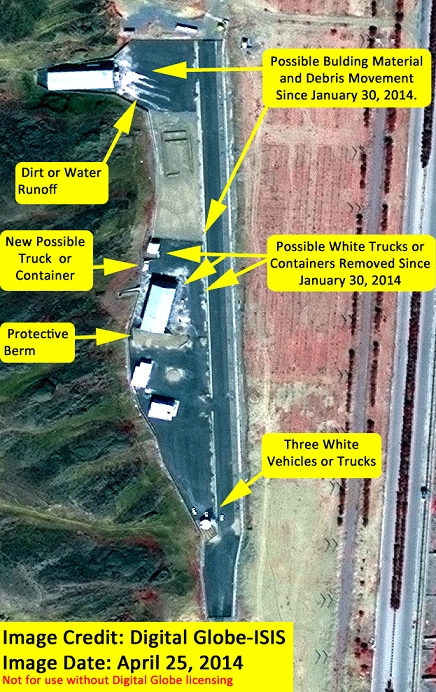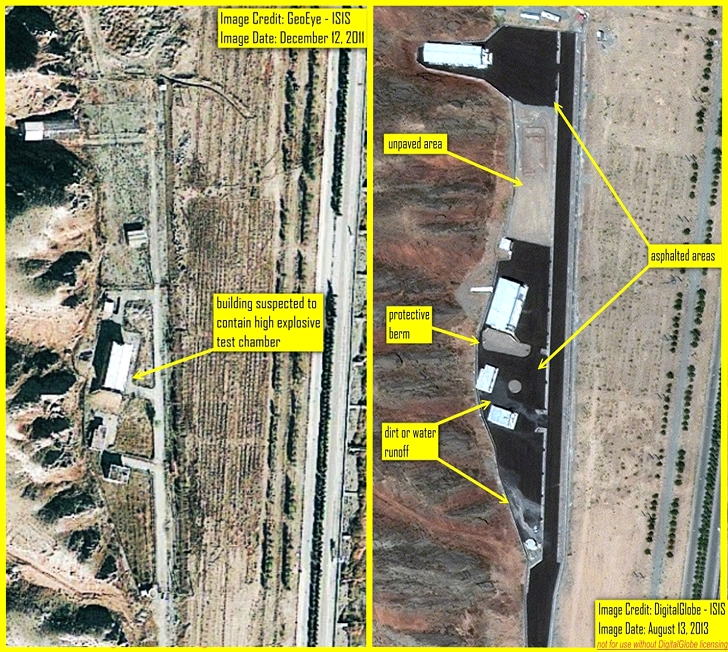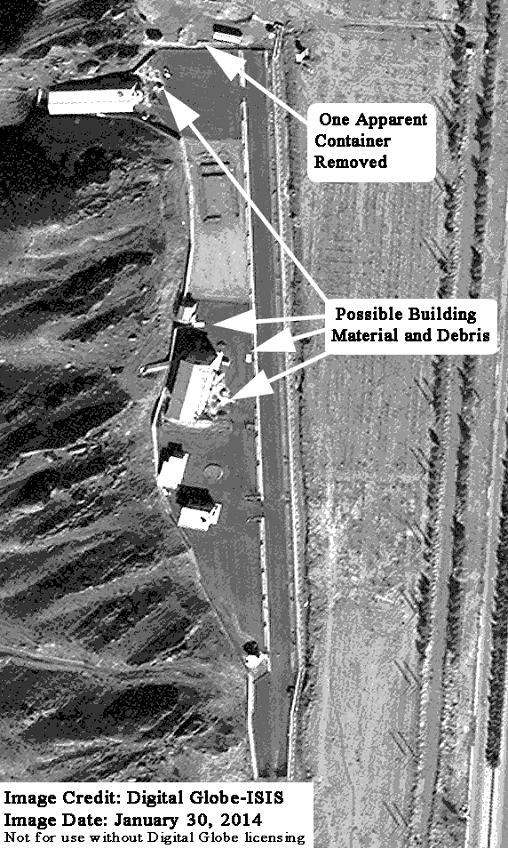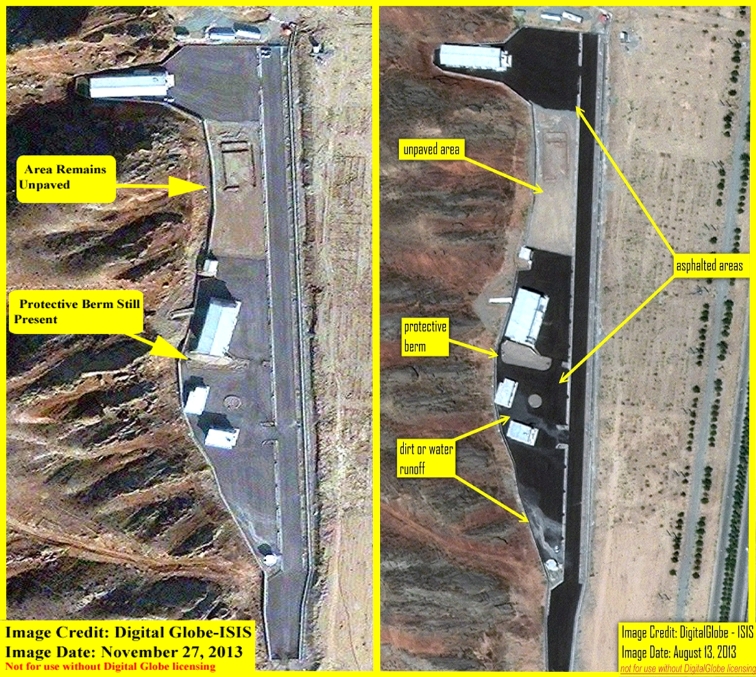Parchin: Resolution Urgent
Prospects of a Comprehensive Solution dim if Iran remains intransigent on Parchin. A deal that does not include Iran addressing the IAEA’s concerns about the past and possibly on-going military dimensions of its nuclear program would undermine the verifiability of the deal, and thus the credibility of a comprehensive deal, in addition to the credibility of the Obama administration. If Iran does not fully comply with its obligations under the Joint Plan of Action and its November 2013 Framework for Cooperation agreement with the IAEA, it will complicate enormously the prospects for extending the interim deal and likely eliminate the possibility of achieving a final one.
Digital Globe imagery dated April 25, 2014, shows renewed signs of external activity at the Parchin military site where Iran is alleged to have conducted work related to nuclear weapons development (see figure 1). Parchin represents a key outstanding issue to the International Atomic Energy Agency (IAEA) in resolving its concerns about Iran’s past and possibly on-going nuclear weapons work and military fuel cycle activities. Before the Parchin issue can be resolved satisfactorily, Iran will need to allow the IAEA to visit the site, provide information and access to officials linked to activities at the site, and possibly permit visits to other sites. In sum, Iran will need to provide far more cooperation on this issue than it has done so far. If it does not, it risks not achieving a final deal with the P5+1 or not receiving further sanctions relief as part of an extended interim deal.
Background
The IAEA first asked to visit the Parchin military complex in early 2012. This request was based on evidence that at least one building was the location of high explosive tests related to the development of nuclear weapons. Additionally, the IAEA had evidence that a former Soviet nuclear weapons expert had aided in the development of testing equipment used inside the building. However, after receiving this request, Iran denied access to the IAEA and instead undertook substantial reconstruction and site modifications (see figure 2). Satellite imagery shows that since early 2012, despite repeated requests by the IAEA and its Board of Governors to stop its site modification activities and allow an IAEA visit, Iran sanitized, demolished portions of, and reconstructed the site in an apparent effort to hide past activities and undermine the IAEA’s ability to conduct effective verification activities. ISIS has monitored developments at the Parchin complex since February 2012 and has catalogued changes at the site (see ISIS Parchin Reports on Iran) and analyzed the work of the ex-Soviet nuclear weapon expert using his writings in Russian and information developed by the IAEA (information can be found here, here, and here).
Recent Activity at the Site
Digital Globe imagery dated April 25, 2014, shows several signs of new activity. Compared to imagery from January 2014, this recent imagery shows that there has been movement of possible building material and debris in front of two main buildings at the site (figure 1). Two trucks or containers have been removed from the area surrounding the suspected high explosives test building, while a larger object, possibly a truck or large container, appears slightly north of it. Dirt or water runoff is visible in front of the northern building (as if there has been a spill or machinery is being cleaned given that the water color indicates the presence of dust, dirt, or soap), and three vehicles are clearly visible at the south entrance. The protective berm adjacent to the suspected high explosive test building continues to be clearly visible.
In February 2014, ISIS confirmed that new activity was taking place at the site, as reported by the IAEA. Figure 3 shows that in February 2014 possible building material and debris appeared in front of the two main buildings and a container was removed (see February 2014 ISIS Imagery Brief). The renewed activity in 2014 followed a roughly six month period in the second half of 2013 where commercial satellite imagery showed no significant visible alterations (see figure 4).
Need for Resolution By continuing to modify the site and denying the IAEA access, Iran is reducing the chances of reaching a comprehensive solution by the initial deadline of July 20, 2013. As described above, before the Parchin issue can be resolved satisfactorily, Iran will need to allow the IAEA to visit the site, provide other information and access to Iranian officials involved with work there, and likely permit visits to other sites. All of these activities are within the IAEA’s legal rights to determine both the correctness and completeness of Iran’s nuclear declarations, which have had a history of being incomplete and sometimes incorrect. Iran’s attempt to circumscribe military sites as no-go zones is legally unjustified and, if successful, would make determinations whether Iran had secret nuclear activities almost impossible. For the IAEA to address its outstanding concerns about past and possibly on-going military nuclear activities, Iran will need to provide far more cooperation on the Parchin issue, and other related issues, than it has done so far. If it does not, it risks not achieving a final deal with the P5+1 or not receiving significant sanctions relief if an extension of the six-month interim deal is necessary.
A deal that does not include Iran addressing the IAEA’s concerns about the past and possible on-going military dimensions of Iran’s nuclear program would undermine the verifiability of that deal. Iran would feel emboldened to resist future IAEA efforts, despite any future implementation of the Additional Protocol, which again would aim both to determine whether Iran’s declaration is correct and complete and to ensure the absence of undeclared nuclear activities and facilities. These efforts will inevitably require visits to military sites and much greater Iranian cooperation.
Moreover, the lack of resolution of the IAEA’s outstanding concerns would represent a significant defeat for the Obama administration. Many senior U.S. officials stated in meetings that a comprehensive deal with Iran is not possible unless Iran addresses the IAEA’s outstanding concerns about past and possible on-going military dimensions. Not holding Iran to this obligation will damage the administration’s credibility.
Iran needs to take seriously its obligations under the Joint Plan of Action and its November 2013 Framework for Cooperation agreement with the IAEA. Otherwise, it complicates enormously extending the interim deal and almost eliminates the possibility of achieving a final one.



